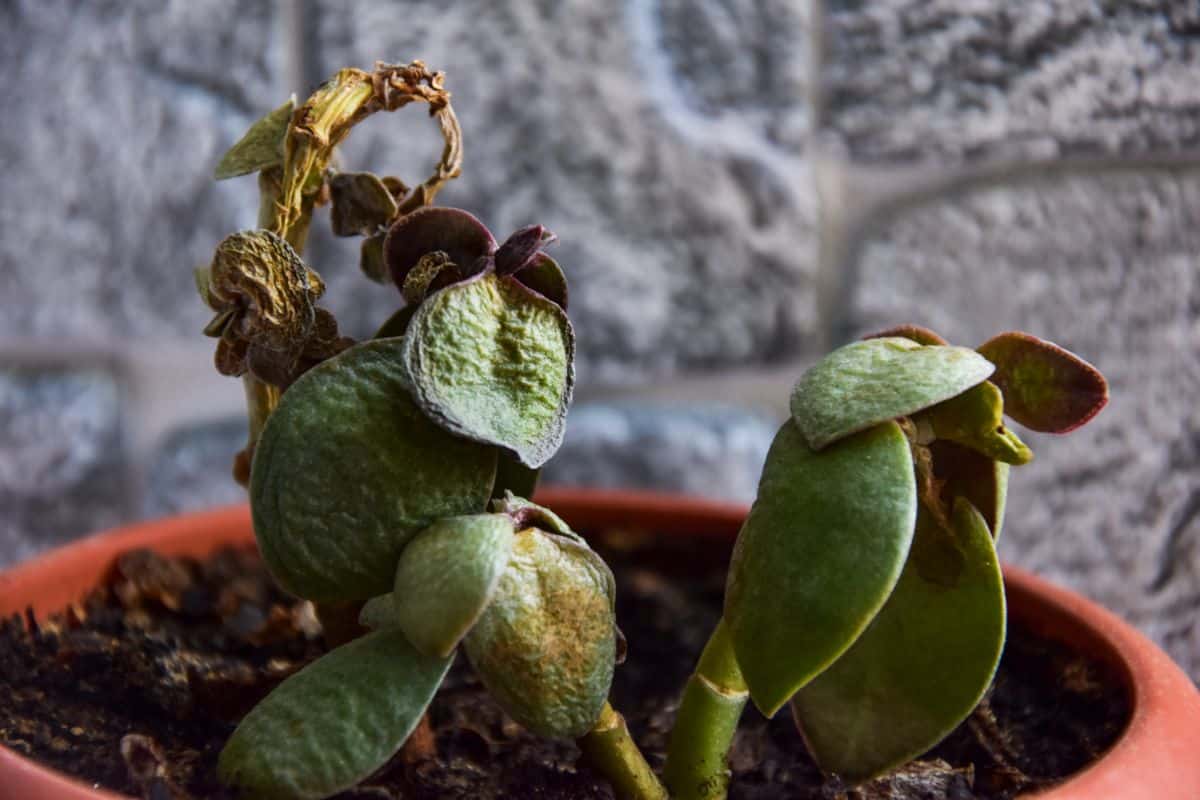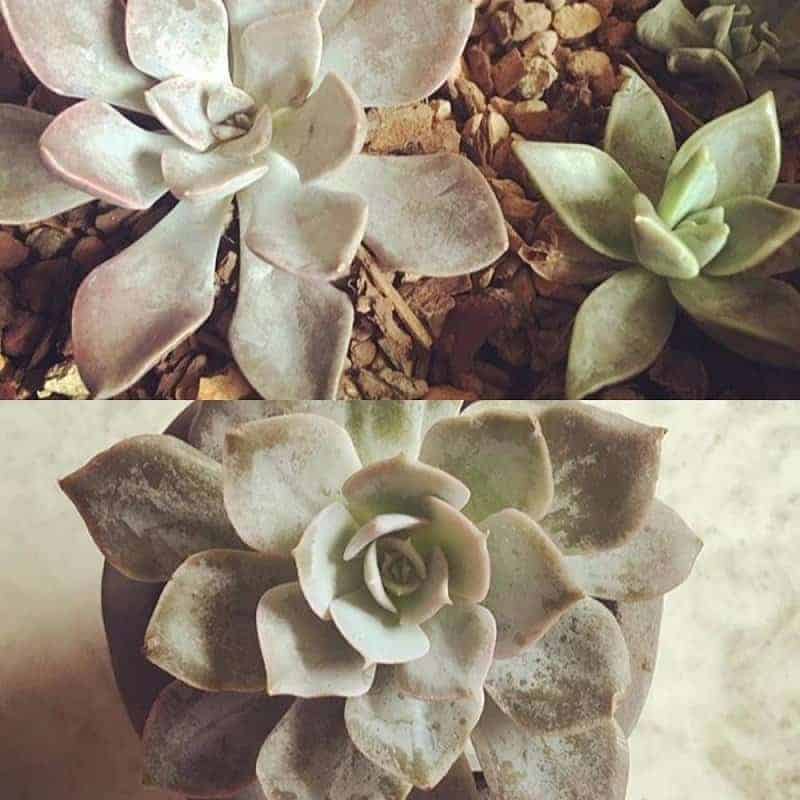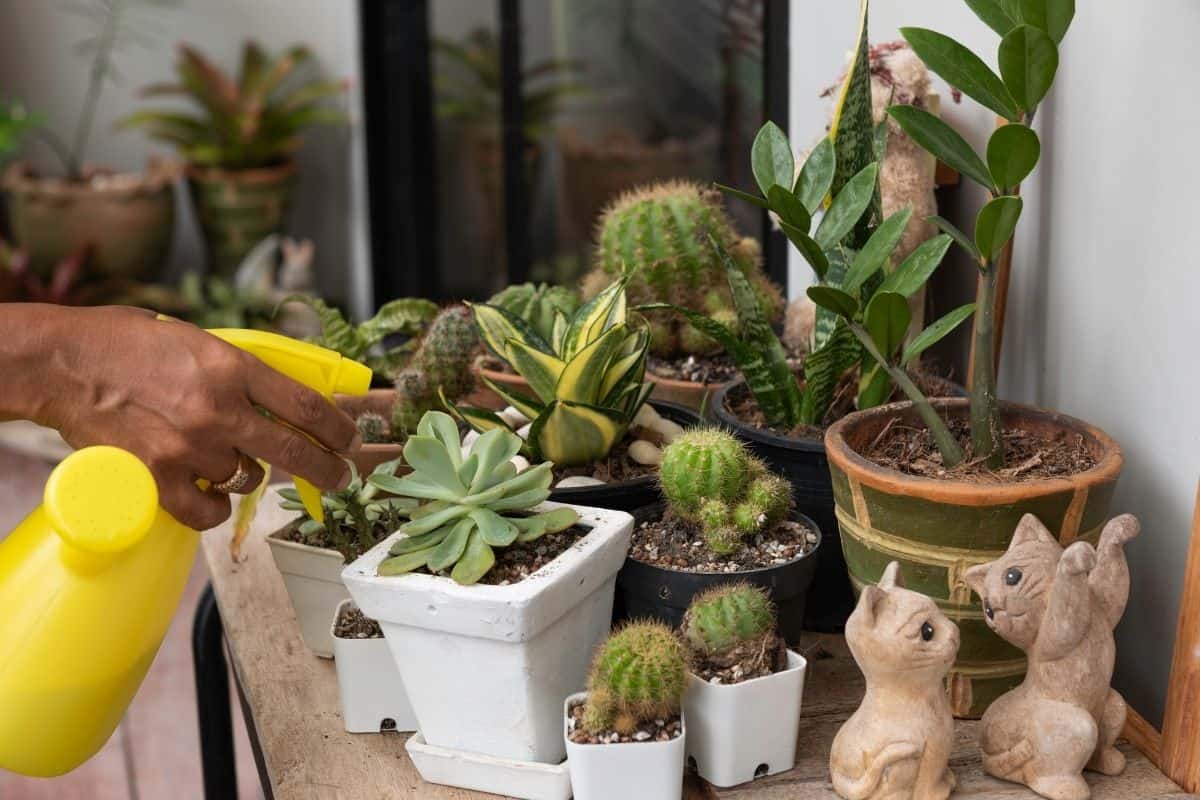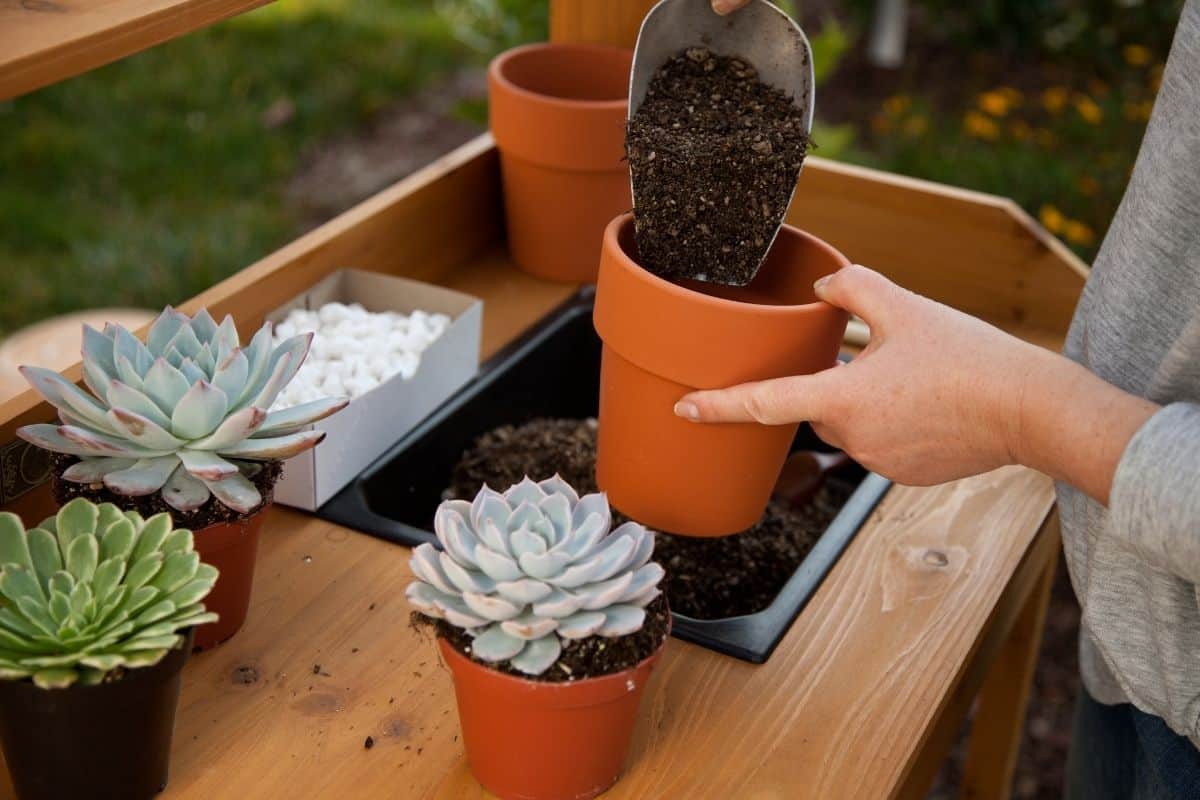
Every succulent lover has experienced the disappointment of discovering that one of their favorite succulents is dying. No matter how much experience with succulents you have, this moment can send you into a state of panic. How could this happen?!
There are many reasons why your succulent may appear to be dying. Knowing the cause of your precious plant’s declining health will help you form the best plan of treatment and give your succulent the best chance of survival.
Jump to:
Reasons Your Succulent May Be Dying

Two of the most common reasons for dying succulents has to do with their watering schedule. Some species of succulents are more forgiving than others, so it may take some practice to figure out the right watering schedule for your plants.
If you need help figuring out how often to water your succulents and cacti, check out our Ultimate Guide.
You can also learn how to deal with common succulent pests if this is your first time dealing with an infestation.
Read Also:
- How to Stop Squirrels Eating Your Succulents
- Mushrooms growing with my succulents
- Purchasing Wholesale Succulents for Businesses and Landscaping
Overwatering
One of the most common reasons for succulent suffering is overwatering. Succulents are drought-loving plants that prefer far less water than many other houseplants. If you water your succulents on the same schedule as your non-succulent houseplants, it’s likely that your succulents are getting too much moisture.
If you’ve planted your succulents in a container without proper drainage or in water retaining soil, it can be especially easy to overwater them. It’s also easy to overwater your succulents and cacti if you live in a humid climate.
Signs of overwatering can include soft or mushy leaves. Overwatered leaves can also have a somewhat wrinkled appearance, which might be confused for underwatering. The main difference here is that underwatered succulents do not feel mushy to the touch.
Depending on the species, the leaves may also have a translucent appearance to them. This is a sure sign that your succulent has absorbed more water than it can handle. Some leaves may brown as they begin to die.
The leaves on an overwatered succulent will also drop at the slightest touch. Typically, the bottom leaves are the first to go.
If overwatering continues beyond these initial symptoms, root rot will probably take hold. The roots will begin to rot and turn black, then the stem, and finally the leaves.
If you happen to catch root rot in its early stages, you may still be able to revive your succulent, but once the rot starts moving up the stem, it’s unlikely that your plant can be saved.
Read Related Topic: How to Treat Scale on your Succulents and Cacti
Underwatering

Since succulents and cacti are so drought-tolerant, many people mistakenly believe that you don’t need to water them hardly at all. While it’s true that these plants can survive long periods without water, they can’t survive with no water.
So how long can succulents go without water? Well, it depends on the species as well as the conditions the plants are grown under. Many succulents also experience periods of dormancy where they can go as long as several months without moisture.
However, it’s safe to say that if your succulents are looking under the weather or appear to be dying, you might be underwatering them. This is especially true if your succulents are looking shriveled during the growing season rather than during dormancy. Most succulents will go dormant in the winter, but you’ll need to research the plants in your garden to be sure.
No products found.
Early signs of underwatering can include wilting and wrinkly or shriveled leaves. Unlike with overwatering, the wrinkling will have the distinct appearance of a plant in need of water. The leaves will be shrunken and may have a crispy texture rather than the squishy leaves of an overwatered succulent.
In species with particularly thick leaves, the leaves may appear quite thin in addition to shriveling. They will have a deflated appearance as they won’t have the plump, firm look of a healthy plant.
Depending on the species of plant you’re dealing with, the stem may also appear wrinkled, deflated, and droopy.
Some succulents, especially cactus, may change color when they’re underwatered. Their colors will appear pale and muted, adding to their overall sickly appearance.
As the plant begins to die, the bottom leaves will the first to completely dry up and fall off. As the plant attempts to shed leaves in order to survive, more leaves will fall off, moving toward the top of the plant.
Pest Problems
Some of the most common pest problems facing succulent gardeners include spider mites, fungus gnats, scale, and mealybugs. Fortunately, most pests can be dealt with easily. As long as you catch the infestation in time, there’s a good chance you’ll be able to revive your succulents.
Signs of a pest infestation will vary according to the specific pests that have invaded your succulent garden. Obviously, if you can see any creepy crawlies on your plants, the cause of your succulents’ poor health will be obvious.
Mealybugs are a common succulent pest that appear as tiny, cottony pests. They are usually white, gray, or brown, depending on the species. They also leave tiny droplets of a sticky substance that may attract ants.
Spider mites are teensy arachnids that create web-like structures on your plants. Their feeding may also leave white or yellow speckles on your plants known as stippling. Mites can range in color from a pale whitish color to a reddish-brown.
Scales are small brown or gray oval-shaped pests typically found on the leaves and stems of your succulents. They are flat or slightly raised and have a waxy sheen. Even once you remove these obnoxious pests, your plant may still bear the scars of a scale infestation.
Fungus gnats are another common pest encountered by succulent gardeners. Though the adult flies don’t harm your plants, they are annoying! The larva does feed on the roots, however, so you want to keep them away from your precious plants.
How to Revive Your Succulent

If you’ve caught your succulents’ health problems in their early stages, it might be possible to revive them. Whether your plants have been overwatered, underwatered, or are suffering from pests, your plants may surprise you with what they can survive.
Remember, succulents and cacti are incredibly hardy plants that survive pretty harsh conditions in their natural environments. Unless you’ve neglected your plants for several weeks or more, you should be able to catch the problem before it’s too late.
This is also why it’s important to check on your plants at least once a week if possible. Giving your succulents a thorough once over will make sure you are monitoring their moisture and sunlight levels and can catch any pest infestation before they cause any serious damage.
Water Therapy
If you’ve accidentally underwatered your succulents, you might want to consider the controversial method of revival known as water therapy. Water therapy is controversial because it involves immersing your succulents’ roots directly in water.
Yes, you read that right. With water therapy you remove your plants from the soil and place their clean roots directly into water. You might be surprised by this if you’ve been told repeatedly that leaving your succulents in standing water will result in root rot.
However, there are plenty of gardeners that swear by water therapy. They claim that it’s a great way to reduce plant stress and rehydrate succulents after periods of underwatering, sun damage, or low to no light environments such as during shipping.
You’ll need to remove your succulents from the soil and rinse off any remaining soil before placing the roots in water. This is to ensure that there are no contaminants in the water that could begin the rotting process.
The best container for water therapy is a small glass jar or cup. The glass sides will allow you to monitor the roots’ health to make sure you aren’t doing further damage. For particularly large succulents, you may need something like a bowl or even a planter without drainage holes.
You don’t need any special type of water for this. Most gardeners just use tap water, but some prefer the healing powers of rainwater. A water bubbler or aerator can help introduce oxygen into the water if you’re worried about your plants’ ability to breathe while underwater.
Once placed in water, succulents are typically left for anywhere between 24 and 72 hours. Some gardeners even leave their succulents in water for up to a week. It all depends on how damaged the plant was to begin with.
It’s important to note that water therapy is best used in emergency situations only. If your succulent is truly dying, water therapy could help, but it should be used only as a last resort.
When using water therapy, it’s crucial that you remove your succulents from the water as soon as they return to their normal plump appearance. Any longer and you risk overwatering them.
Drying Out
If you’ve consistently overwatered your plants or accidently left them outside in a heavy rain, you might consider attempting to dry them out in order to prevent any damage from excess moisture.
In order to dry out your succulents’ containers, you’ll want to pour out any standing water that might be sitting on the surface of the soil or in the saucer below the pot. Empty out the saucer and gently tip the pot on its side to pour the water out.
After removing excess water, you can then place the container in a warm, sunny spot to help encourage evaporation. Just be sure to keep a close watch on your plants for signs of sunburn. You don’t want to further damage your plants in your attempts to revive them.
If you’re serious about drying the plants out or suspect that root rot might be reason for your succulents’ unhealthy appearance, you can also remove the plants from the soil.
To remove your succulents or cacti from the soil, gently remove them from the container and lightly massage the roots to remove excess soil. You’ll want to be careful so that you don’t damage the roots any more than necessary.
If you’re worried about root rot, you might also consider rinsing off excess soil before laying your plants out to dry. This will give you a chance to better inspect the roots as well as removing any organic material that could lead to further rot.
Once removed from the soil, you can lay your succulents out to dry for a few days. Again, you’ll need to keep them protected from direct sunlight and sudden drafts.
After you feel that the roots have dried out enough to no longer be at risk of rotting, you can replant the pot. If you’ve made the mistake of using the wrong type of soil or a container without a drainage hole, this is your opportunity to make better choices.
Pruning
Pruning can also be an option in your attempts to revive your dying succulent. For example, if you have removed your succulent from the soil to dry it out and see that some of the roots have begun rotting, you can cut away the damaged roots to prevent the rot from spreading further.
Cutting away the rotten areas of an overwatered plant won’t always save the plant’s life, but it’s worth a try if you’re running out of other options.
You can also try pruning away areas that have been heavily damaged by sunburn or pests. This can help your succulent spend its energy on new growth or repairing less damaged leaves or stems.
Pruning can also be used as a last resort if you’re no longer confident that you can save your plant. If pests or root rot have taken hold of your plant, you may be able to behead the plant or take cuttings for propagation.
If you are able to take cuttings for propagation, try to cut away healthy areas of the plant and make your cuts at least an inch or two above any infected or damaged areas. If your succulents have been infested with pests, you’ll also need to make sure you aren’t bringing any pests along on the cuttings to continue the infestation elsewhere.
Repotting

Depending on what is causing your succulent to die, repotting may be an option for reviving it. As previously mentioned, if you’ve previously planted your succulent in water retaining soil or a container without drainage, repotting can be a great way to correct those mistakes and improve the health of your plants.
Repotting may also be necessary if your succulents have depleted the soil of nutrients, become pot bound, or if you suspect any type of fungal infection or pest infestation.
If you’re really worried about pests, bacteria, or fungi, you may also consider sterilizing your soil. It’s a relatively easy process that can be done at home. It’s not always necessary, but it can help put your mind at ease if you’re worried about transferring harmful pathogens from one container to the next.
Repotting is best done when your plants are ready to be watered, but before you actually water them. Removing plants from dry soil is usually easier and less damaging to the root systems. Once you’ve gotten your succulent settled into its new container, you can give it a big drink of water to help it recover.
If you don’t have much experience with repotting, we’ve got you covered. Read our guide to repotting succulents here.
Pest Treatment
If you’ve discovered pests in your succulent garden, the obvious course of action to revive your dying succulent is to exterminate the pests. As mentioned earlier in the article, it’s best if you can properly identify the pest first so that you can choose the right method of treatment.
While it may be tempting to reach for the convenience of pesticides, most expert gardeners discourage their usage. By using harsh chemicals on your plants, you may potentially be exposing yourself, your family members, and even your pets to potentially harmful toxins.
There are plenty of more natural pest control options on the market that are healthier for your plants and your household.
One of the most common methods of pest control is the usage of neem oil. Neem oil is a naturally occurring pesticide found in the seeds of the neem tree. Neem oil can be applied directly to the plant and works by affecting the insects’ ability to feed and reproduce.
Neem oil is incredibly effective, but usually must be applied more than once in order to completely eliminate the infestation. It works on a variety of pests, but it can be helpful to research the specific pests you’re dealing with to be sure.
Insecticidal soap is another common method of getting rid of garden pests. You can find it at your local nursery or you can make your own. Insecticidal soap is simply soap diluted in water. It works by penetrating the insects’ bodies and drying them out.
If you’d prefer to let nature do the hard work for you, you may also look into using beneficial insects in your garden. Insects like fungus gnat predators, ladybugs, and predatory mites work by feeding on other insects that feed on your plants.
You Might Also Like:


